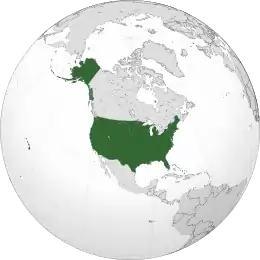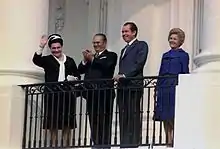United States–Yugoslavia relations
United States–Yugoslavia relations were historical foreign relations between United States and now split-up Kingdom of Yugoslavia (1929–1941) or Socialist Federal Republic of Yugoslavia (1945–1992). During the existence of the country relations oscillated from mutual ignorance, antagonism to close cooperation and significant direct American engagement.


United States |
Yugoslavia |
|---|---|
History
Interwar period
The Kingdom of Yugoslavia was created in the aftermath of the World War I under the influence of the Fourteen Points self-determination ideas by President Woodrow Wilson. Prior to Yugoslav unification United States established diplomatic relations with the Kingdom of Serbia from 1882 and the Principality of Montenegro from 1905.
World War II
During World War II in Yugoslavia, the United States initially supported the royalist Yugoslav government in exile. When the Nazis invaded Yugoslavia in the spring of 1941, the United States decisively supported the Chetniks in the first years of the war. This however changed once British sources recognized Yugoslav Partisans as the only significant resistance movement which will rise to become the most effective anti-Axis resistance movement during the war.
Initial postwar years
In the initial period after the war relations between the two countries were poor with Yugoslavia being perceived as the closest Soviet ally, and the country in which Communist party gained power without any significant Soviet support.[1] This phase lasted in a short period after the end of the World War II in 1945 and before the beginning of the Cold War in 1947. This period was characterized by Soviet conciliatory diplomacy towards West and much more belligerent Yugoslav foreign policy involved in issues such as the Free Territory of Trieste and Greek Civil War. Relations were further strained when two USAF C-47 Skytrain cargo aircraft were shot down over Yugoslavia in the space of two weeks.[2]
Relations after 1948

The 1948 Tito-Stalin split represented the major turning point in the relations of United States and the new socialist republic. Yugoslavia first requested assistance from the United States in summer 1948. Truman administration decided to provide substantial aid, loans and military assistance to Yugoslavia despite of some concerns caused by earlier relations.[3] Tito received US backing in Yugoslavia's successful 1949 bid for a seat on the United Nations Security Council, against Soviet opposition. In 1949, the United States provided loans to Yugoslavia, and in 1950 the loans were increased and followed by large grants and military aid. Even though the Yugoslavs initially avoided asking for military aid believing that it would be a pretext for a Soviet invasion, by 1951 Yugoslav authorities became convinced that Soviet attack was inevitable and Yugoslavia was included in the Mutual Defense Assistance program. United States recognized strategic importance of an independent and successful socialist Yugoslavia as an subversive model for other states which were part of the East Bloc.
The Yugoslav diplomacy dealt successfully with the shifts in the focus of American policy from Kennedy's "Grand Design," Johnson's "building bridges" appeal, Nixon's personal diplomacy, to Carter's focus on the human rights.[4] Yugoslavia pursued a highly independent foreign policy and maintained leadership of the international Nonaligned movement that created a competing ideology and challenged the two superpowers.[4]
 Eleanor Roosevelt and Josip Broz Tito in 1953
Eleanor Roosevelt and Josip Broz Tito in 1953 President and Mrs. Broz, President and Mrs. Nixon overlooking arrival ceremony on the South Lawn from the White House.
President and Mrs. Broz, President and Mrs. Nixon overlooking arrival ceremony on the South Lawn from the White House. Tito with Rosalynn & Jimmy Carter during Tito's third state visit to USA in 1978.
Tito with Rosalynn & Jimmy Carter during Tito's third state visit to USA in 1978. Yugoslav representative Dragoslav Pejić talking to George H.W. Bush at the United Nations Security Council meeting on 14 July 1988.
Yugoslav representative Dragoslav Pejić talking to George H.W. Bush at the United Nations Security Council meeting on 14 July 1988.
Yugoslav crisis, breakup and wars
In the initial stage of the Yugoslav crisis and the Breakup of Yugoslavia at the end of the Cold War the United States were strong advocates of Yugoslav integrity. At the same time, Washington believed the crisis was an issue for Europe to resolve. Failure of the European Community and subsequently the European Union to deal with the Yugoslav Wars led to significant American involvement in the region. In this process Presidency of Bill Clinton provided security guarantees and efforts for smaller and weaker former Yugoslav republics of Bosnia and Herzegovina and North Macedonia. This led to some frictions with Croatia and significant one with the Serbia and Montenegro (which US rejected to recognize as the sole successor to Socialist Yugoslavia) and Bosnian Serbs which escalated in 1995 Operation Deliberate Force and 1999 NATO bombing of Yugoslavia and lasted all up until the Overthrow of Slobodan Milošević.
See also
- Yugoslavia and the Non-Aligned Movement
- Yugoslavia–European Communities relations
- Yugoslavia at the 1932 Summer Olympics
- Yugoslavia at the 1980 Winter Olympics
- Yugoslavia at the 1984 Summer Olympics
- United States at the 1984 Winter Olympics
- Bosnia and Herzegovina–United States relations
- Croatia–United States relations
- Kosovo–United States relations
- Montenegro–United States relations
- North Macedonia–United States relations
- Serbia–United States relations
- Slovenia–United States relations
- Yugoslav Americans
- Death and state funeral of Josip Broz Tito
References
- Pierre Maurer (1985). "United Statesyugoslav Relations: A Marriage of Convenience". Studia Diplomatica. Egmont Institute. 38 (4): 429–451. JSTOR 44835732. Retrieved 4 December 2020.
- "Cold War Shootdowns". Retrieved 2 May 2016.
- HENRY W. BRANDS JR. (1987). "Redefining the Cold War: American Policy toward Yugoslavia, 1948–60". Diplomatic History. Oxford University Press. 11 (1): 41–53. JSTOR 24911740. Retrieved 4 December 2020.
- Josip Mocnik (2008). "United States-Yugoslav Relations, 1961-80: The Twilight of Tito's Era and the Role of Ambassadorial Diplomacy in the Making of America's Yugoslav Policy". History Ph.D. Dissertations. Bowling Green State University. Retrieved 4 December 2020.
